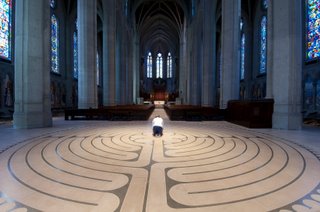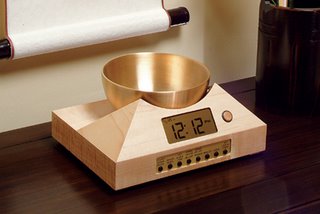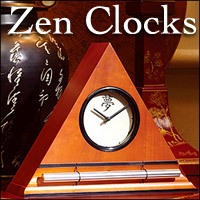|
 Secure Site
Secure Site
|
 |
Archive for the 'Chime Alarm Clocks' Category
 The famous moss garden of Saihō-ji. Saihō-ji is a Rinzai Zen Buddhist temple located in Matsuo, Nishikyō Ward, Kyoto, Japan. The temple, which is famed for its moss garden, is commonly referred to as “Koke-dera”, meaning “moss temple”, and is also known as “Kōinzan Saihō-ji”.
The famous moss garden of Saihō-ji is situated in the eastern temple grounds. Located in a grove, the garden is arranged as a circular promenade centered around Golden Pond. The pond is shaped like the Chinese character for “heart” or “mind” and contains three small islands: Asahi Island, Yūhi Island, and Kiri Island. The area around the pond is said to be covered with more than 120 varieties of moss, believed to have started growing after the flooding of the temple grounds in the Edo Period (1603 to 1868).
 Bamboo Zen Chime Clocks & Timers adapted from wikipedia.org
Now & Zen
1638 Pearl Street
Boulder, CO 80302
Posted in Bamboo Chime Clocks, Chime Alarm Clocks, Japanese Inspired Zen Clocks, Meditation Timers, Meditation Tools, Now & Zen Alarm Clocks, Progressive Awakening, Yoga Timer, Yoga Timers by Now & Zen
 Mindful Walking- Spiritual Journey Through a Labyrinth labyrinths: walking practice can be a spiritual journey
In the Socratic dialogue that Plato produced as Euthydemus, Socrates describes the labyrinthine line of a logical argument:
“Then it seemed like falling into a labyrinth: we thought we were at the finish, but our way bent round and we found ourselves as it were back at the beginning, and just as far from that which we were seeking at first.”
… Thus the present-day notion of a labyrinth as a place where one can lose [his] way must be set aside. It is a confusing path, hard to follow without a thread, but, provided [the traverser] is not devoured at the midpoint, it leads surely, despite twists and turns, back to the beginning.
Mindful Walking, a Spiritual Journey inspired from wikipedi.org
 Digital Zen Alarm Clock Now & Zen
1638 Pearl Street
Boulder, CO 80302
Posted in Chime Alarm Clocks
 Brigitte Mars, author, herbalist, and amazing raw food chef from Boulder, CO Peter’s Fairy Godmother, Brigitte Mars (an herbalist, famous author, and raw food chef from Boulder, CO) just gave him the Yoga Garden Game for his birthday! Our whole family loves to play this game at home and when we travel. We use our Zen Timer/Alarm Clock to practice holding each pose for 5 seconds.
Here are Peter’s favorite yoga Poses:
- Frog Pose
- Snake Pose
- Tree Pose
- Cat Pose
- Cow Pose
- Butterfly Pose
- Downward Facing Dog Pose
- Bridge Pose
- Bamboo Pose
 Yoga with kids in nature
 - Bamboo chime clock and yoga timer
Children love to move their bodies! Yoga improves their ability to concentrate and focus. Yoga helps children to be calm too!
Posted in Chime Alarm Clocks, Now & Zen Alarm Clocks, Yoga Timer, Yoga Timers by Now & Zen, Zen Timers
 Sharaku Toshusai, The actor Matsumoto Yonesaburo as Shinobu - Stay Calm, Be Thankful Write a gratitude list. If your average day feels more like a triathlon, saying a quick thanks can help you stay calm. According to a study in the journal Integrative Physiological and Behavioral Science, people who were coached to be more appreciative experienced a 23 percent drop in their levels of the stress hormone cortisol after a month. Before you tackle your to-do list, take a moment to jot down one thing you’re grateful for today.
Try Meditating More Often:
Although meditation can be done in almost any context, practitioners usually employ a quiet, tranquil space, a meditation cushion or bench, and some kind of timing device to time the meditation session. Ideally, the more these accoutrements can be integrated the better. Thus, it is conducive to a satisfying meditation practice to have a timer or clock that is tranquil and beautiful.
Using a kitchen timer or beeper watch is less than ideal. And it was with these considerations in mind that we designed our digital Zen Alarm Clock and practice timer. This unique “Zen Clock” features a long-resonating acoustic chime that brings the meditation session to a gradual close, preserving the environment of stillness while also acting as an effective time signal.
 Time Your Meditation with a Gentle Bowl/Gong Timer from Now & Zen, Inc. Now & Zen’s Meditation Timer Store
1638 Pearl Street
Boulder, CO 80302
(800) 779-6383
Posted in Bamboo Chime Clocks, Chime Alarm Clocks, Meditation Timers, Meditation Tools, mindfulness practice, Well-being
 Wake Up Refreshed - Try the Most Gentle Alarm Clock with Acoustic Chime Although the occasional all-nighter is OK, people who regularly skimp on z’s can’t undo sleep deprivation’s detrimental effects by simply hitting the snooze button on weekends, says a new study in the journal Science of Translation Medicine.
Contrary to popular belief, the energy you feel after a Saturday morning sleep session is only short lived, according to the study. Chronic sleep loss has a cumulative effect on performance. Why? Lack of sleep raises levels of the stress hormone cortisol and affects a person’s ability to respond to stimuli, says Catherine Darley, ND, founder of Seattle’s Institute of Naturopathic Sleep Medicine. Sleep also plays a key role in mood regulation and overall physical and mental functioning.
Waking up in the morning should be as pleasant as falling asleep at night. The Zen Alarm Clock‘s gradual, gentle awakening is transformative.
 Wake up with gradual, beautiful acoustic chimes. The Zen Alarm Clock transforms your mornings and gets you started right, with a progressive awakening
Boulder, Colorado—an innovative company has taken one of life’s most unpleasant experiences (being startled awake by your alarm clock early Monday morning), and transformed it into something to actually look forward to. “The Zen Alarm Clock,” uses soothing acoustic chimes that awaken users gently and gradually, making waking up a real pleasure.
Rather than an artificial recorded sound played through a speaker, the Zen Clock features an alloy chime bar similar to a wind chime. When the clock’s alarm is triggered, its chime produces a long-resonating, beautiful acoustic tone reminiscent of a temple gong. Then, as the ring tone gradually fades away, the clock remains silent until it automatically strikes again three minutes later.
The frequency of the chime strikes gradually increase over ten-minutes, eventually striking every five seconds, so they are guaranteed to wake up even the heaviest sleeper. This gentle, ten-minute “progressive awakening” leaves users feeling less groggy, and even helps with dream recall.
 The Zen Alarm Clock transforms mornings, awakening you gradually with a series of gentle acoustic chimes Once you use a Zen Clock nothing else will do Now & Zen – The Zen Alarm Clock Headquarter Store
1638 Pearl Street
Boulder, CO 80302
(800) 779-6383
Posted in Chime Alarm Clocks, sleep, Sleep Habits, wake up alarm clock
 Buddha Set aside half an hour.
Begin by calling to mind a sage or saint, or another human being you deeply admire. It should be someone you have a feeling for and whose teachings you understand—Jesus, or Buddha, Gandhi, St. Teresa of Avila, the Baal Shem Tov, or your own teacher, if that teacher has been a reliable example of enlightenment.
If no one comes to mind, choose one of the qualities of enlightened consciousness—such as compassion or love. Now, think deeply about that person or the quality you want to embody. Consider how it might be to look through that person’s eyes. If it’s a quality, ask yourself, “How would it be at this moment to look through the eyes of love?” Ask yourself, “How did this being treat others?” How might he or she behave while living your life? (Yes, what would Jesus do?) Imagine facing a challenge, a big conflict, the desertion of someone close. How would that person handle it?
Now, close your eyes and imagine that the spirit of that person (or that quality) inhabits your body. Inhale, thinking to yourself, “Christ’s love lives within me, as my love,” or “Buddha’s state of enlightenment is my enlightenment,” or “The courage of Gandhi is my courage.” Exhale, thinking, “That inner state fills my body.”
Do this for a few moments. Then ask yourself, “How would I move through the world if I truly embodied the qualities of this being? How would I treat myself? How would I be with my partner? my kids? my parents? the people on the bus? What would it be like to interact with others?”
Let your imagination completely open to this practice, imagining yourself enlightened, saturated with love. For the remainder of the half hour, act out of that experience. Be the great being you’re imagining yourself to be. Act out the quality you want to imbibe. Do this for half an hour a day for a week and see if you notice the effect.
Although meditation can be done in almost any context, practitioners usually employ a quiet, tranquil space, a meditation cushion or bench, and some kind of timing device to time the meditation session. Ideally, the more these accoutrements can be integrated the better. Thus, it is conducive to a satisfying meditation practice to have a timer or clock that is tranquil and beautiful. Using a kitchen timer or beeper watch is less than ideal. And it was with these considerations in mind that we designed our digital Zen Alarm Clock and practice timer. This unique “Zen Clock” features a long-resonating acoustic chime that brings the meditation session to a gradual close, preserving the environment of stillness while also acting as an effective time signal. The Digital Zen Clock can be programmed to chime at the end of the meditation session or periodically throughout the session as a kind of sonic yantra. The beauty and functionality of the Zen Clock/Timer makes it a meditation tool that can actually help you “make time” for meditation in your life.
adapted from YogaJournal.com by Sally Kempton
 Zen Gong Alarm Clock and Timer for Meditation and Yoga Now & Zen’s Gong Meditation Timer
1638 Pearl Street
Boulder, CO 80302
(800) 779-6383
Posted in Chime Alarm Clocks, Meditation Timers, Meditation Tools, mindfulness practice
 Why Do Some People Need More Sleep? New research suggests it is in our genes…
Some people are genetically programmed to need less sleep than the rest of us, according to a new paper published this week in Science. A rare genetic mutation lets its carriers function happily and healthily even with hours less sleep each night than doctors normally recommend.
Researchers discovered the enviable gene variant after studying a family in which two members, a mother and a daughter, seemed to need much less daily rest than their close relatives. The women slept just 6.25 hours per night, while others in the family averaged 8.06 hours. The researchers then sequenced some genes they thought could be responsible, and discovered that both mom and daughter — unlike others in the family — had a never-before-seen mutation in a gene that’s known to affect circadian rhythms.
Next, to test whether that gene variant was really the cause of mom and daughter’s shortened sleep time (and not just some freak coincidence), the researchers genetically engineered a group of mice to express the newly found mutation. Sure enough, those mice had a typical activity period that’s more than an hour longer, on average, than that of a normal mice. The mutant mice also seemed to need less catch-up sleep than others after a period of sleep deprivation.
The new findings give a fascinating insight into why humans vary so much in how long we sleep — with a good night’s shut-eye ranging anywhere from six hours to nine, depending on whom you ask. But the result can hardly explain everything. This new-found gene variant appears in just 1 in 60 families that were studied, according to a follow-up paper that’s also published this week in Science. For genes to explain the full range of human sleep needs, then, there would have to be other genes involved too.
adapted from Time.com, by Laura Blue
Our Digital Zen Clock’s long-resonating Tibetan bell-like chime makes waking up a beautiful experience – its progressive chimes begin your day with grace. When the clock’s alarm is triggered, the acoustic chime bar is struck just once … 3-1/2 minutes later it strikes again … chime strikes become more frequent over 10 minutes … eventually striking every 5 seconds until shut off. As they become more frequent, the gentle chimes will always wake you up – your body really doesn’t need to be awakened harshly, with a Zen Clock you’re awakened more gradually and thus more naturally. Unlike artificial recorded sounds coming out of a tiny speaker in a plastic box, natural acoustic sounds transform your bedroom or office environment.
 The Zen Alarm Clock transforms mornings, awakening you gradually with a series of gentle acoustic chimes Once you use a Zen Clock nothing else will do. Now & Zen – The Zen Alarm Clock Store
1638 Pearl Street
Boulder, CO 80302
(800) 779-6383
Posted in Bamboo Chime Clocks, Chime Alarm Clocks, sleep, Sleep Habits, Well-being
 What Do Dreams Mean...Kasamori Osen Ippitsusai Buncho Recent developments in dream research won’t make sense without first touching on the academic thunderbolt of 1977, when a paper by two Harvard neurophysiologists, Allan Hobson and Robert McCarley, ran in the American Journal of Psychiatry. At the time, Sigmund Freud’s theory of dreams (which holds, in part, that dreams preserve sleep by distracting the brain with reflections of the unconscious) was a pillar of psychiatry. In The Brain as a Dream State Generator: An Activation-Synthesis Hypothesis of the Dream Process, the Harvard pair challenged Freudian theory on virtually every point. They argued that dreams are nonsense created when the forebrain makes “the best of a bad job in producing even partially coherent dream imagery from the relatively noisy signals” sent up to it from the brain stem at the onset of REM. Their paper served to yank dreaming from the realms of the psychological and plonk it in a dreary, physiological bucket.
Later, the English molecular biologist Francis Crick, a co-discoverer in the 1950s of the structure of the DNA molecule, drained a little more romance from dreaming. His and theoretical biologist Graeme Mitchison’s “reverse learning” theory held that dreams rid the brain of superfluous notions, and that without this regular flushing brain overload would manifest as hallucinations and obsessions. There are echoes of this idea in the perspective of Drew Dawson, director of the University of South Australia’s Centre for Sleep Research: “I tend to think of dreaming as a bit like backwashing the swimming pool filter.”
While hugely influential, Hobson and McCarley’s Activation-Synthesis model attracted hordes of critics, who protested that many dreams aren’t merely cognitive fragments nor a succession of chaotic images, but so story-like, sequential and dramatic that the thinking brain must surely have played a more substantial role in their production than the last-minute editing of a pile of neural bloopers. And there’s the matter of lucid dreaming, in which people become aware in the course of a dream that they are, in fact, dreaming, and are able to control the course of events—a phenomenon that strengthens the case for higher-brain involvement in dream construction. The lucid dreamer can apparently apply certain techniques to prolong the dream and take it in delightful directions. “The experiences are so convincing,” says Victoria University’s Bruck, “it seems as if another level of reality exists.”
 Dreams Serve to Process Memories But the wrecking job on the notion that dreams are a random by-product of REM sleep was carried out by the South African neuroscientist and psychoanalyst Solms, who was working at the Royal London Hospital in the 1990s when he made his career-defining discoveries. Solms wasn’t alone at the time in realizing that dreaming occurred outside periods of REM, that it was also common at sleep onset and shortly before waking in the morning. But he found an even weaker spot in the Hobson-McCarley hypothesis. If their theory was right, then people with damage to a part of the brain stem called the pons—the on-off switch for REM sleep—shouldn’t be having dreams. Solms, however, had five patients with lesions in precisely that region, and while they weren’t having REM, they were nonetheless reporting dreams.
Even more interesting to Solms were 53 Royal London Hospital patients with healthy brain stems who said they’d stopped dreaming. Most of them had damage to the part of the brain that generates spatial imagery. That made sense: if you can’t create pictures in your mind, how are you going to dream? It was the circumstances of the remaining nine patients that fascinated Solms. They had damage to the white matter of the ventromesial quadrant of the frontal lobes, an area linked to the transmission of the chemical dopamine and crucially involved in motivation, urges and cravings. These patients still experienced REM sleep but reported having lost both the capacity to dream and all sense of spontaneity, drive and love of life. They did what they were told and that was about it.
It seemed to Solms that dreams must themselves be associated with driving urges—a very Freudian take—but he needed more evidence in the form of more people with lesions in this particular spot. Nowadays, damage to that part of the brain is rare, normally a result of strokes or tumors. But it was a lot more common in the ’50s and ’60s when some mental illnesses were treated by removing it in an operation called a prefrontal leukotomy. Solms waded through the literature and found hundreds of case studies in which the effects of this procedure were described. To his amazement, reported loss of dreaming was one of them. “So I thought I’d discovered something new,” says Solms, “but it turned out to be something we’d documented long ago but had forgotten.” In the field of dreams, however, his findings were no less significant for that: Solms had shown REM and dreaming to be dissociable states and produced a compelling case that the higher brain has the central role in dream creation.
Solms, who believes science is getting closer to answering the key questions about dreaming, is leading two studies at the University of Cape Town with that goal in mind. One involves using functional magnetic resonance imaging to try to disentangle the REM brain from the dreaming brain. He wants to obtain images of the dreaming/non-dreaming brain at sleep onset and note the differences between the two. “If we can image what’s going on at that point, then we’ll get a clear handle on what mechanisms are important for dreaming as opposed to REM sleep,” says Solms, who predicts a key role for the motivational part of the brain.
His other study involves comparing the sleeping ability of subjects who dream with that of subjects who can’t because of brain lesions. Solms argues that because our motivational drive is fully active while we’re asleep, our brain’s way of keeping us asleep and undertaking the necessary repairs is by tricking us, through dreams, into thinking we’re up and about and pursuing our desires. It’s the neurological equivalent of putting on a DVD for the kids so the main players in the house can get some shut-eye. “Dreams replace the real actions that are instigated by our motivational impulses while we’re awake,” Solms says. His hunch is that the non-dreamers in his study will wake up more often during the night than the dreamers, especially during REM sleep: “The dream,” he says, “is what keeps you asleep.”
Others approach dreams from a different angle. An argument that resonates with many is that whatever the explanation for dreaming, humans must do it for the same reason that all mammals have done it for more than 100 million years; any theory must make as much sense when applied to a rabbit as to a person. In the same Darwinian vein, sleeping and dreaming must serve important functions because they’re vulnerable states and natural selection would have eliminated them if they didn’t provide compensating benefits. In the ancestral environment, human life was short and perilous; ever-lurking predators threatened survival and reproductive success. The biological function of dreaming, argues Antti Revonsuo, professor of psychology at the University of Turku, Finland, is to simulate threatening events so to prepare the dreamer for recognizing and avoiding danger.
 Why do We Dream? The threat-simulation theory, first presented in 2000, “is built on the actual empirical evidence we have concerning the content of dreams,” Revonsuo says. “It’s surprising how many theories of dreaming there are that are not based on any systematic review of the evidence.” He cites studies showing that, typically, dreams are too seldom sweet, and that negative feelings, dangerous scenarios and aggression are over-represented. Based on ongoing work with PhD student Katja Valli, Revonsuo estimates that the average “non-traumatized” young adult has, conservatively, 300 threat-simulation dreams a year. In the dreams of both men and women, male strangers and wild animals are most often the enemy, and the dreamer’s typical responses are running and hiding, often in a state of terror.
If dreams are biased toward simulating ancestral threats, the traces of these biases would be strongest early in life, before the brain has adjusted to the realities of the contemporary environment. Sure enough, Revonsuo says, research shows that animals make up about 30% of all characters in the dreams of children aged 2-6 compared to 5% of adults’. True, the animals of children’s dreams are often fluffy and harmless, but almost half the time they’re frightening creatures—snakes, bears, lions, gorillas—that children would seldom, if ever, have encountered in waking life.
The reason we don’t dream about reading and writing, Revonsuo speculates in his original paper, is not because these activities don’t engage our emotions but because they’re “cultural latecomers that have [yet] to be effortlessly hammered into our evolved cognitive architecture.” Revonsuo knows that his theory pleases neither Freudians nor neuroscientists. “If, for the supporters of the psychological theories, it grants too little meaning to dreams,” he says, “for the supporters of neurophysiological random-noise theories, it grants dreaming far too much.”
Harvard’s Stickgold believes dreams have a different function entirely. “I think it’s pretty clear now that sleep and dreaming serve to process memories from the last day and all the way back,” he says. “Sleep can strengthen memories… and help extract the meaning of events by building associative networks with other memories. Dreaming is probably a high-level version of this processing.” Clearly, he adds, you don’t have to remember your dreams for these processes to work. “The brain is tuning your memory circuits as you sleep, and remembering the imagery created during this process may be fun, may be instructive, but is almost undoubtedly a freebie.”
Stickgold’s evidence includes an experiment he led in 2000 when Harvard researchers were able to elicit the same dream in a bunch of people as they drifted off to sleep. They did this by exposing 27 subjects to an intensive three-day course in the computer game Tetris, which involves assembling geometric shapes. By the second night of training, 17 subjects had reported having the same dream image—falling Tetris pieces—indicating to Stickgold that the need to learn prods the brain to dream. More of these kinds of studies are needed, he says, “because as we learn to manipulate dream content, we can start to figure out what the rules are that the brain uses in selecting material for our dreams.” Though not sold on the memory-consolidation theory, the Dream & Nightmare Laboratory’s Nielsen sees merit in it. Of course, if dreaming does embed memories it’s doing it in ways we don’t understand, he says. “Perhaps memory needs to be sliced and diced and then reassembled in odd ways in order for consolidation to be maximized.”
Psychotherapists tend to regard a lot of the research into dreaming as missing the point. Scientists, they say, can theorize all they like about dreaming’s function and physiological underpinnings, but why dreams matter is their effect on the dreamer. The man contemplating an extramarital affair dreams of the dire consequences of having one. He awakens to feel not only exquisite relief that he was dreaming but determined to walk the line. If, as Solms believes, dreams spring from the motivational part of our brain at a time when other parts that inhibit us are off-line, “it follows that there’s value in interpreting dreams,” he says. They provide a “privileged, unfiltered access” to what’s on a person’s mind. Mark Blagrove, a lecturer in psychology at the University of Wales, where he runs a sleep laboratory, thinks it’s possible the search for a biological function of dreaming could be futile. “It could just be,” he says, “that our elaborate dreams are a side effect of the fact that we have a highly evolved imagination.”
All the competing theories on why we dream may be wrong. One or more of them could be right. “I have no doubt that dreams can be enjoyable, informative, even revelatory to the dreamer,” says Harvard’s Stickgold. “But dream analysis is a more tricky question. The more dogmatic and doctrinaire the beliefs of the analyst, the less useful and potentially more destructive the analysis process becomes.” People should understand, he adds, that dreams aren’t constructed with the goal of delivering a message; they don’t have an inherent meaning. “But when you look at your dreams after you wake up… you can often feel the associative networks that were activated during dream construction, and trace them back a ways, and maybe discover a new way of looking at events in your life, of looking at yourself, at others, or at the world at large.” Maybe that’s worth a third of our lives asleep, perchance dreaming.
Boulder, Colorado—an innovative company has taken one of life’s most unpleasant experiences (being startled awake by your alarm clock early Monday morning), and transformed it into something to actually look forward to. “The Zen Alarm Clock,” uses soothing acoustic chimes that awaken users gently and gradually, making waking up a real pleasure. Rather than an artificial recorded sound played through a speaker, the Zen Clock features an alloy chime bar similar to a wind chime.
When the clock’s alarm is triggered, its chime produces a long-resonating, beautiful acoustic tone reminiscent of a temple gong. Then, as the ring tone gradually fades away, the clock remains silent until it automatically strikes again three minutes later. The frequency of the chime strikes gradually increase over ten-minutes, eventually striking every five seconds, so they are guaranteed to wake up even the heaviest sleeper. This gentle, ten-minute “progressive awakening” leaves users feeling less groggy, and even helps with dream recall.
adapted form Time.com, by Daniel Williams
 Gentle Chime Alarm Clock for a Progressive Awakening Now & Zen – The Zen Alarm Clock Store
1638 Pearl Street
Boulder, CO 80302
(800) 779-6383
Posted in Bamboo Chime Clocks, Chime Alarm Clocks, Dreams, sleep, Sleep Habits
 Utamaro Ukiyo-e, Two Ladies With Flowers The “Floating World” described the urban lifestyle, especially the pleasure-seeking aspects, of the Edo-period Japan (1600 –1867).
The term is also an ironic allusion to the homophone (the same as another word but differs in meaning) “Sorrowful World”, the earthly plane of death and rebirth from which Buddhists sought release.
The contemporary novelist Asai Ryoi, in his Ukiyo monogatari (“Tales of the Floating World”, c. 1661), provides some insight into the concept of the floating world:
… Living only for the moment, turning our full attention to the pleasures of the moon, the snow, the cherry blossoms and the maple leaves; singing songs, drinking wine, diverting ourselves in just floating, floating; … refusing to be disheartened, like a gourd floating along with the river current: this is what we call the floating world…
Ukiyo floating world adapted from wikipedia.org
One of the ultimate Zen like experiences is waking-up from a great slumber refreshed and energized. Your mind and body are harmoniously one, both alert and focused. Having a refreshed mind and body are two keys to a natural and Zen lifestyle. Waking up in the morning should not be a loud and abrupt awakening, but rather it should be a peaceful positive experience. The right natural alarm clock can transition your deep and tranquil sleep into a serene start to consciousness. Imagine a long-resonating Tibetan bell-like chime waking you up to a beautiful morning experience.
The right alarm clock can be the most beneficial investment for you. With our Now & Zen natural alarm clock you are awakened more gradually and thus more naturally. Now & Zen is focused on creating a naturalistic lifestyle, and our clocks are an example of our philosophy.
 Meditation Clock Timer- Zen Alarm Clock, Ukiyo-e Hokusai Wave Dial Face Now & Zen – The Zen Alarm Clock Store
1638 Pearl St.
Boulder, CO 80302
(800) 779-6383
Posted in Beauty, Cherry Blossoms, Chime Alarm Clocks, Hokusai Wave, Japanese Inspired Zen Clocks, Meditation Timers, Meditation Tools, Now & Zen Alarm Clocks, Progressive Awakening, Zen Timers
 koi fishes in the pond Koi or more specifically nishikigoi, (literally “brocaded carp”), are ornamental domesticated varieties of the common carp (Cyprinus carpio) that are kept for decorative purposes in outdoor ponds and water gardens. They are also called Japanese carp.
adapted from wikipedia.org
One of the ultimate Zen like experiences is waking-up from a great slumber refreshed and energized. Your mind and body are harmoniously one, both alert and focused. Having a refreshed mind and body are two keys to a natural and Zen lifestyle. Waking up in the morning should not be a loud and abrupt awakening, but rather it should be a peaceful positive experience. The right natural alarm clock can transition your deep and tranquil sleep into a serene start to consciousness. Imagine a long-resonating Tibetan bell-like chime waking you up to a beautiful morning experience.
The right alarm clock can be the most beneficial investment for you. With our Now & Zen natural alarm clock you are awakened more gradually and thus more naturally. Now & Zen is focused on creating a naturalistic lifestyle, and our clocks are an example of our philosophy.
 mindful of the koi
Now & Zen – The Zen Alarm Clock Store
1638 Pearl Street
Boulder, CO 80302
(800) 779-6383
Posted in Chime Alarm Clocks, Now & Zen Alarm Clocks, Progressive Awakening, Zen Timers
« Previous Page — « Previous Entries
Next Entries » — Next Page »
|
|
|
|